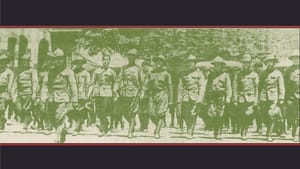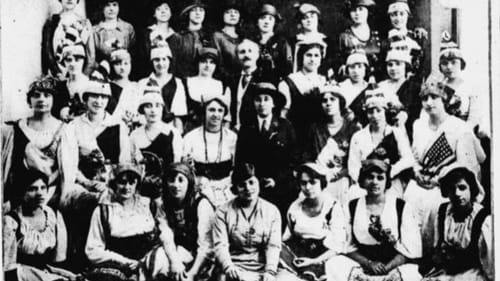Stay in the Loop
BSR publishes on a weekly schedule, with an email newsletter every Wednesday and Thursday morning. There’s no paywall, and subscribing is always free.
Philly’s first WWI home front
‘Little Italy in the Great War’ by Richard N. Juliani

Richard Juliani’s Little Italy in the Great War: Philadelphia’s Italians on the Battlefield and Home Front finds Italian immigrants to America confronting an awkward dilemma in 1915. Italy wanted them home to fight in what became World War I. The United States, clinging to isolationism, would soon ask them to register as aliens, provide necessary labor, become citizens, and join its army. Italians had relocated for a variety of reasons, some for work, others to avoid war, and not all intended to stay.
In his new book, Juliani describes the impact of World War I on our city’s Italian community, then the second largest in America. Through individual stories gleaned from period sources, Juliani puts human faces on existential choices about home, loyalty, and belonging.
Sons summoned home
World War I would find Philadelphia’s Italian immigrants, regardless of the reason they came, and force them to quickly declare their intentions toward the country they’d left and the country they’d chosen.
Though Italy and the United States would ultimately become allies, Italian immigrants occupied an increasingly difficult position between May 1915, when Italy declared war, and April 1917, when the US entered the fray. “As they embraced that cause while America hesitated, Italians momentarily separated themselves from other Americans,” Juliani writes. “And undeterred by American neutrality, they would, when beckoned by Italy, parade in the streets before marching to the docks while erstwhile tourist steamers, serving as impromptu military transports, waited to carry them back to their homeland.”
Italy required emigrant men ages 20 to 39 to register beginning in June 1915. As a physician, Joseph Pasceri was called early, becoming the first in Philadelphia to serve in the Italian army. Those returning to fight were not guaranteed the cost of passage, and no provision was made for any dependents in America. In July 1915, the US Department of Labor increased pressure on aliens here, declaring that any who joined a “belligerent” army would be denied US citizenship.
The newspaper bridge
Though separated by an ocean, immigrants here remained connected to news of the war through proactive journalism. When Italy declared war, Philadelphia’s Evening Public Ledger, a daily newspaper, published the first of what would total 250 dual-language editorials and news articles. Bilingual coverage provided non-English speakers timely reporting to supplement Italian-language periodicals.
Journalist Pasquale Adalberto Caporale, a frequent Public Ledger contributor, was known as the “wartime voice of Little Italy.” Focusing on immigrants at home as well as war news, he introduced the Italian community in Philadelphia to itself and, importantly, to the Public Ledger’s readership.

Conflicted loyalties, dueling drafts
Eventually the US, like Italy, had to build an army. Juliani writes that it was a task “made more difficult by recruitment from a far more diverse population than ever before in American history.”
In May 1917, a month after entering World War I, the US instituted the Selective Service Act, which required unmarried men ages 18 to 40 to register for the draft. Immigrants who had begun the citizenship process for unrelated reasons, such as improving employment opportunities, were suddenly exposed to the possibility of military service. About 23,000 Italian-born men would register across the region, 15,000 of them from Philadelphia.
Aliens who hadn’t applied for citizenship still had to register but weren’t eligible for military service. Like some registrants, Pasquale Abanese planned to become a citizen. Others signing up waived the exemption. But the ambiguity surrounding immigrants’ status drew criticism. Opportunists hoping to stoke anti-immigrant animosity termed them “alien slackers.”
Naturalization efforts became widespread, in part to assuage security concerns about immigrants. English instruction was offered, as well as help filing citizenship papers. For those reporting to military training, streamlined citizenship procedures were established in May 1918 with passage of the Alien Naturalization Act.
From many, one
More significant to Italians’ assimilation than the formalities of citizenship, Juliani explains, was the crucible of war—training, living, fighting, and dying together in camps, on ships, and in trenches. Conversely, these experiences introduced troops of other backgrounds to the Italians.
Wartime assimilation also took place at home. Noting that Italian neighborhoods became home fronts two years before the rest of Philadelphia, Juliani says, “Italian women, from the beginning of the war, would join as they had in their native land, in the effort to produce materials for the troops at the front.” In addition to providing essential labor, as their daughters would in World War II, women organized support for relief groups and relatives in Italy, and assisted families here whose wage earners were serving, or had become casualties. They sold Liberty Bonds, rallied, and participated in other patriotic, morale-building events.

Though war did not erase problems of insularity, language, discrimination, and mistrust between immigrants and the wider city, it created situations in which Italian immigrants became more integrated in the broad population, and increased awareness of the Italian community within that larger population. It accelerated a transformation in thinking on both sides, moving those who once thought of themselves as Italians in America toward becoming Italian-Americans.
Journalism, now and then
Juliani’s almost granular treatment of his subject reflects his personal connection and the quality of his sources. The author’s father, Leonardo Antonio Iuliani, came to America in 1922 after serving as an infantryman in the Italian army. He settled in Camden and worked as a tailor.
Because Juliani had access to archived periodicals, notably the Evening Public Ledger, he was able to document many stories like his father’s. It’s a reminder of the way in which newspapers once connected communities, and a tribute to contemporary technology that such sources have been preserved.
Ironically, that same technology has contributed to the decline of contemporary newspapers. It’s not that future researchers won’t have access to a wealth of information: they surely will. But it will be in a thousand places, each with its own editorial standard, and therefore may lack credibility, accuracy, or impartiality. This book makes an excellent case for why professional journalism, particularly old-school newspapering, matters, and for the importance of the technology that makes it possible and accessible.
What, When, Where
Little Italy in the Great War: Philadelphia’s Italians on the Battlefield and Home Front. By Richard N. Juliani. Philadelphia: Temple University Press, 2020. 314 pages, softcover; $37.95. Visit here.
Sign up for our newsletter
All of the week's new articles, all in one place. Sign up for the free weekly BSR newsletters, and don't miss a conversation.
